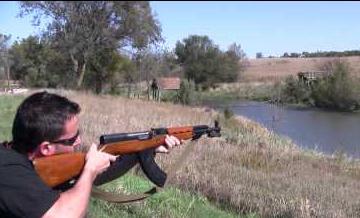And those rapid gains may intensify in 2012 even if farm income levels off as a new generation of Preppers secure their future against economic and social collapse.
In a seven-state survey by the Federal Reserve Bank of Kansas City, Nebraska farmland prices led the way with increases of 41.4 percent for irrigated cropland, 38.6 percent for non-irrigated cropland and 26.1 percent for ranchland. For the region, the increases averaged 30 percent for irrigated cropland, 25 percent for non-irrigated cropland and 16 percent for ranchland.
The gains are fueled by profits from grain and livestock, boosting demand from buyers. At the same time, few people are selling farmland, partly because landowners are unsure where they would invest money from a land sale.
Last year, the same survey reported an average 20 percent increase, including 24 percent for cropland in Nebraska. The survey also covers Missouri, Kansas, Oklahoma, Wyoming, Colorado and New Mexico.
Although Iowa was not included in the latest survey, a similar recent study said farmland prices in Iowa rose 27 percent over the past year.
“What we’re hearing from bankers and from land brokers is that the primary buyer is going to be the farmer,” said Jason Henderson, who headed the farm survey. He is the executive in charge of the Kansas City bank’s Omaha branch. “The highest auction prices tend to be emerging when you have two competing neighbors bidding.”
Henderson said Nebraska’s price increases are the highest in the region partly because farm income has been better than in the other states, where drought has cut crop yields.
Bruce Johnson, a University of Nebraska farm economist, said in a recent study that farmland values may remain high, but factors such as weather, the value of the U.S. dollar, interest rates or political unrest abroad could cause prices to drop.
High-quality irrigated cropland in Nebraska has sold for record prices topping $10,000 an acre- the largest percentage gain in the 34 years that the university has been tracking the prices.
Low debt means farmers can avoid a financial crunch if interest rates rise sharply. But if farm income drops this year, some farmers might borrow money on their land to pay for planting and harvesting their 2013 crops. Demand for farm loans is the lowest since the 1980s, the banks in the survey said, but farm spending on household goods and improvements is up, thanks to high farm income. Farm credit conditions strengthened, with more loans being repaid.
Nearly 40 percent of the bankers said they had more money available to lend to qualified borrowers. Farm loan demand is weak, they said, sending interest rates down to an average of 6.2 percent for operating loans and 5.8 percent for real estate loans.
powkey Portable Power Station 350W, 260Wh/70,000mAh Backup Lithium Battery, 110V Pure Sine Wave Power Bank with 2 AC Outlets, Portable Generator for Outdoors Camping Travel Hunting Emergency
Now retrieving the rating.
$192.98 (as of April 18, 2024 14:24 GMT +01:00 - More infoProduct prices and availability are accurate as of the date/time indicated and are subject to change. Any price and availability information displayed on [relevant Amazon Site(s), as applicable] at the time of purchase will apply to the purchase of this product.)200W Portable Power Station, Powkey 120Wh/33,000mAh Power Bank with AC Outlet, 110V 6 Outputs Solar Generator External Battery Pack with LED Light for Home Use and Outdoor Camping
Now retrieving the rating.
31% OffPortable Power Station 600W, Powkey 296Wh Battery Backup with 2 Pure Sine Wave AC Outlets, USB-C PD100W and 2 Wireless Chargers, Solar Generator (Solar Panel Optional) for Outdoor Camping/RVs/Home Use
Now retrieving the rating.
10% OffFoldable Solar Panel Charger 60W with 18V DC Output (11 Connectors) for 100W~350W Portable Power Stations Jackery/Rockpals/Flashfish/Enginstar, Portable Solar Generator for Outdoor Camping Van RV Trip
Now retrieving the rating.
$98.99 (as of April 18, 2024 14:24 GMT +01:00 - More infoProduct prices and availability are accurate as of the date/time indicated and are subject to change. Any price and availability information displayed on [relevant Amazon Site(s), as applicable] at the time of purchase will apply to the purchase of this product.)10W USB LED Light for Camping Garage Warehouse Car Truck Fishing Boat Outdoor Portable Bulb, Emergency Light, Children Bed Lamp
Now retrieving the rating.
$9.99 (as of April 18, 2024 14:24 GMT +01:00 - More infoProduct prices and availability are accurate as of the date/time indicated and are subject to change. Any price and availability information displayed on [relevant Amazon Site(s), as applicable] at the time of purchase will apply to the purchase of this product.)





